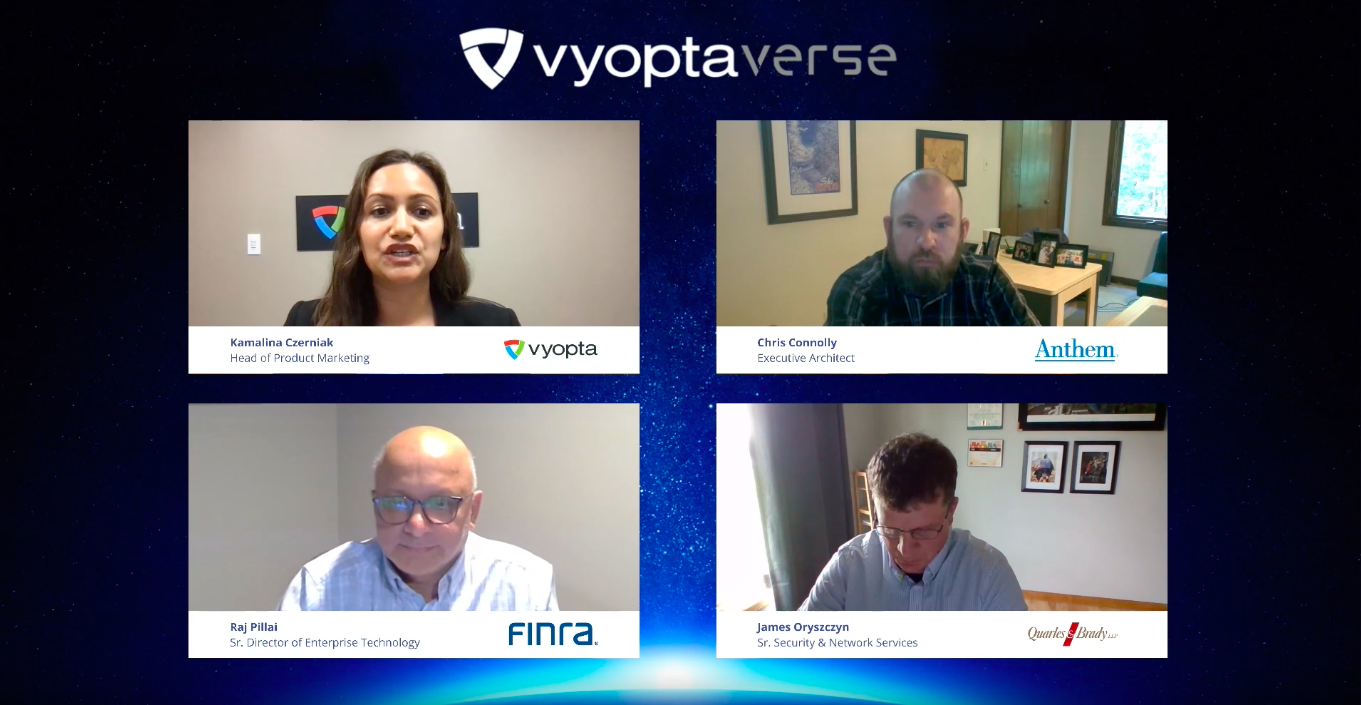During the first-ever Vyoptaverse conference on collaboration intelligence, experts in unified communications and collaboration technology gathered to share how their industry has been transformed by the effects of the Covid-19 pandemic. With the business world gradually moving to hybrid work scenarios, workers and employers find themselves with lots of flexibility as well as plenty of questions about how and where people will do their jobs going forward, with a special eye on digital collaboration.
The panel, moderated by Vyopta’s senior manager of product marketing Kamalina Czerniak, brought together Chris Connolly, executive architect for Anthem; Raj Pillai, director of financial industry regulatory authority for Finra; and James Oryszczyn, director of security and network services for Quarles & Brady LLP.
Here are some of their thoughts about Vyopta’s growing value and the importance of digital collaboration going forward.
Connolly on…
Tracking quality: “We use Vyopta to track the reliability of the platforms that we’re using, so we can see how many folks are having issues. That also helps us drill down into the root causes of what are causing those issues. It’s able to consolidate the data from multiple platforms so we can give a holistic view of what collaboration is across the Webex and the Microsoft platform for our folks.”
Effective digital collaboration: “During the migration when we moved a lot of those folks off the Webex platform onto teams we could see who were the people who stayed behind using Webex. Because of that we could have great conversations with them around why they were staying behind, specific use cases that they didn’t feel were met by Teams and that helped us in targeting with Microsoft how to address those issues.”
Workspace data: “Our corporate real estate folks are really looking forward to when we go back to the office, being able to use the data from all of the conference spaces so that we can see really detailed information on how people’s behavior is going to change. We used (Vyopta) before Covid so that we understood space planning and things of that nature. Now that things are going to change we’ve made a lot of assumptions about how we think folks’ behaviors are going to change, but we’re really looking forward to having that nice, accurate data so that we can either verify those assumptions or correct ourselves for where we guessed wrong.”
Oryszczyn on…
Migrating to digital collaboration: “What we had is a lot of very well-built, extensive conference rooms that generally the attorneys would go down in the conference room, interview clients and give the white glove service. The biggest challenge was teaching users how to use some of the tools they’d had for years without a whole lot of use, which in the beginning was Skype For Business. We realized that Skype For Business didn’t work very well for things like sharing externally. We made the transition to Microsoft Teams and everybody really picked up on Teams, so that is our go-to platform going forward and we have Webex as a secondary platform.
Pillai on…
Returning to offices: “We told our workers if you want to come to the office, you can go in there and you wear this certain kind of (contact tracing) device to walk around the building. We never limited anybody not coming to the facility. The second thing we did is we realized that we need some sort of a workspace booking system. If you’re going to go in a hotel type of (desk situation). We deployed a solution called Condeco on the large campus buildings, so if you had a flexible work arrangement you can book a space and then come into the building. We feel that going forward it’s going to be for the most part about the technology, that most folks are going to be flexible and the other folks in the business line part of things, I think they’ll come back to the office.”
Multi-vendor environments: “One of the biggest asks from our end user community is can we tone down the tools. We have Microsoft Office 365, and Zoom, and we also have Webex. So we’re looking at all three tools to see what are best in class that we can select. We have a lot of requirements around internal/external communication and our challenge is that when people use multiple tools, where do you go for one consolidated view? That’s been a real challenge for us, so we use Vyopta a lot since it gives us one single pane of glass and will be useful between the tools sets.”
Preventing meeting burnout: “Our leadership really want to know, since there is something called Zoom fatigue… we really didn’t have the tools to tell what people are using, and how often. We knew from the host perspective that people are using something but in terms of, if you ask somebody how many meetings they participated in none of the tools could tell you what’s happening between all these multiple tools. Between using Jabber, everything in Microsoft Teams and Zoom and Webex we couldn’t really tell how many meetings I participated in any given day. We engaged Vyopta on a special consulting arrangement and they came through for us. That gave us a dashboard so we can really go in and look at how everybody’s using these tools.”
Hear more from the experts at Vyoptaverse.
Chad Swiatecki is a business writer and journalist whose work has appeared in Rolling Stone, Billboard, New York Daily News, Austin Business Journal, Austin American-Statesman and many other print and online publications. He lives in Austin, Texas and is a graduate of Michigan State University. Find him online on LinkedIn.








